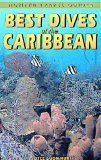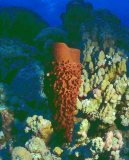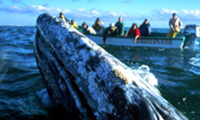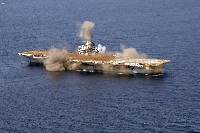This News Service has moved. Click here for the latest news.
07 June 2006
Review of Double Cross, a diving novel by Patrick Woodrow

Double Cross
Patrick Woodrow
Arrow, 2005
422pp. £6.99
0 0994785 9 5
Review by Andrew Reay-Robinson
An all-action novel, with plenty of diving, written by
an experienced diver. The author's diving knowledge means
that you do not have to endure the cringe-worthy diving
sequences in a lot of novels written by people with
limited if any diving experience.
The book's hero is a British underwater photographer who
accidentally kills a woman before going on the run to
protect his career. The woman's death, however, provides
him with vital clue to his inheritance and what follows
is a fast paced globetrotting adventure with plenty of
diving, drug trafficking baddies and a thrilling climax.
The book is very easy to read with simple dialogue
and is a good escapist read.
Ideal to relax with between dives on a diving holiday
or liveaboard.
Available with 20% off from amazon.co.uk at
http://www.amazon.co.uk/exec/obidos/ASIN/0099478595/1286
and from amazon.com at
http://www.amazon.com/exec/obidos/ASIN/0099478595/
For more diving book reviews, and interviews with authors, see the SCUBA Travel Bookshelf.
--
Subscribe to SCUBA News (ISSN 1476-8011) for more free news, articles, diving reports and marine life descriptions - http://www.scubatravel.co.uk/news.html

01 June 2006
Greater Risk to Loggerhead Turtles from Longline Fishing
 Researchers studying Loggerhead Turtles, Caretta caretta, have found that most adult turtles forage in the open ocean, with only the very largest foraging in coastal waters. This is different to what was previously thought, and has profound implications for the conservation of these turtles.
Researchers studying Loggerhead Turtles, Caretta caretta, have found that most adult turtles forage in the open ocean, with only the very largest foraging in coastal waters. This is different to what was previously thought, and has profound implications for the conservation of these turtles.The study, published in the latest issue of Current Biology, says that although tbe protection of coastal areas may be attainable, the ocean-going turtles are dispersed over more than half a million square kilometers. So the largest turtles may be protected but the more numerous smaller adult turtles are at a very great risk from being caught by fisheries in the east Atlantic. Not deliberately, but as by-catch.
Previously it was thought that only juveniles foraged in the open ocean. Using satellite tracking, the new research shows that the majority of adults are also exposed to longline fisheries. The scientists conclude that fisheries in the east Atlantic will likely require complex and regionally tailored actions to protect the turtles.
Experiments over the last few years have shown that large “G”-shaped circle hooks effectively reduce turtle by-catch rates compared to smaller “J”-shaped hooks. Large circle hooks are effective without compromising commercial viability for some target species. Studies comparing small circle hooks (5.1 cm width or smaller) to smaller (4.1 cm width or smaller) J-shaped hooks found no significant difference in turtle bycatch rates. Other strategies include setting gear below the depths where turtles are in relatively high densities, using fish instead of squid for bait, single hooking fish bait versus threading the hook through the bait multiple times, timing the retrieval of line to minimize gear soak during the daytime and area and seasonal closures.
According to the WWF, some 260,000 loggerhead turtles are caught annually on longlines set for tuna, swordfish, and other fish.
Journal Source: Current Biology Volume 16, Issue 10 , 23 May 2006
Other Sources: Review of the State of Knowledge for Reducing Sea Turtle Bycatch in Pelagic Longline Gear
WWF
Photo copyright Pedrín López, http://www.seaturtle.org/
--
Subscribe to SCUBA News (ISSN 1476-8011) for more free news, articles, diving reports and marine life descriptions - http://www.scubatravel.co.uk/news.html

26 May 2006
Interview with Diving Author Joyce Huber

Joyce Huber's first book was a travel guide for divers titled Best Dives of the Caribbean. The original was published in 1988, but an updated version is out this month.
This first diving book spawned another on the sea - Best Dives' Snorkeling Adventures. This came about when she put her email address in an edition of the diving book, and was inundated with questions. Not from divers but from snorkellers.
After many nights staying up until 3 am answering the e-mails, Huber decided the snorkellers should have their own book. Her publisher, Michael Hunter, didn't see a market in snorkelling, but she had worked in print for so many years that it seemed simple enough for her to put a snorkelling guide together for them. It is now in its third edition.
Her scuba diving guide has been in need of an upate for a few years - but she put it on hold as her co-author/dive buddy/husband was diagnosed with brain cancer in 2002. He died in 2003. She was so devastated she did nothing till 2005. His name as co-author is on the new edition of the guide as he contributed much time to it.
The first dive book was the result of 20 years of dive travel and note taking. Back in the 1970's, Joyce and her husband Jon put on slide shows of underwater sites for their local dive club. Friends asked about places to stay, best time of year, where to eat etc. It grew into a book from there.
Joyce signed a contract with Dodd Mead publishing, but the publishing company folded. Putnam Publishing bought out the contract. They dropped "Best Dives". Since she was a new writer, she hired a crusty editor - Eliot Tozer - to make the book more saleable. He got hooked on the subject and took off for Bermuda for a resort course. He nearly drowned when his mustache let water in his mask.
Simon and Schuster's editor then wanted the book, but she was over-ruled as no one had ever published a dive-travel guide and they didn't want to be the first. Meanwhile, Michael Hunter started a travel book company. He moved to south Florida and lived on the beach where he saw lots of divers going in and out of the ocean so he figured there must be a market. He published the first Best Dives book in 1988 and it was an instant success. "We meant it to be for new divers" says Joyce "but everyone loved it."
You might imagine that writers on diving have been a major influence on Joyce Huber, but oddly enough she sites instead people from Flying Magaine and Aviation International News. She worked on aviation magazines as an art director for many years and in corporate and general aviation doing promotional work. She is a licensed seaplane pilot.
Huber grew up in northeastern New Jersey, an area that is a suburb of New York City. She spent summers in south Jersey swimming and beach-combing and watching seaplanes. After studying art at Pratt Institute and the Art Students League she worked as everything from a fashion designer to a mural painter. She went back to school for writing specifically to do the dive books when she was 35 years old. She's now 58 now.
Joyce Huber's books are available from Amazon, with up to 35% off.
Best Dives in the Caribbean is available from:
amazon.com and amazon.co.uk
Best Dives' Snorkeling Adventures is available from:
amazon.com and amazon.co.uk
--
Subscribe to SCUBA News (ISSN 1476-8011) for more free news, articles, diving reports and marine life descriptions - http://www.scubatravel.co.uk/news.html

25 May 2006
Creature of the Month: Tube Sponge, Acervochalina sp
 With their varied colours and intricate shapes, sponges
With their varied colours and intricate shapes, spongesadd beauty to the reef or rock. Some sponges are
greenish, violet or pinkish in colour because they
harbour symbiotic algae. The more symbionts and light,
the stronger the colour. When there is low light
these sponges are a much paler colour - almost
white.
The sponge uses the algae as a source of oxygen, a
screen against sunlight and as a food source. The
algae profit by a secure habitat.
Sponges are amongst the simplest members of the animal
kingdom. They have no digestive, nervous or
circulatory systems for example.
The lack of sophistication in sponges has been shown in
a classic experiment. A sponge was pushed through fine
silk to completely break it down. However, it soon
succeeded in resassembling itself.
A sponge feeds by drawing water into its central cavity
through its pores - the tiny holes covering its body.
The filtered water leaves through the big outlet pores.
Our picture (http://www.scubatravel.co.uk/sponge.html)
shows a Tube sponge, Acervochalina species. This sponge
can produce a chemical which is highly toxic to
Pocillopora and Acropora corals.
Further Reading:
----------------
Great British Marine Animals, Paul Naylor
http://www.scubatravel.co.uk/britishmarine.html
The Red Sea in Egypt Part II, Farid S Atiya
--
Subscribe to SCUBA News (ISSN 1476-8011) for more free news, articles, diving reports and marine life descriptions - http://www.scubatravel.co.uk/news.html

19 May 2006
Why was Sipadan Damaged?
Well, it turns out that the barge operators had been given a contract to build tourist facilities such as toilets and restaurants on the island (source: Malaysian National News Agency).
When the Deputy Chief Minister of Sabah (who is also Tourism, Environment and Culture Minister) was asked how the barge could sail to the protected island, he said the contractor who was involved in the project was not given any approval by Sabah Parks to use such a huge vessel to transport the building materials or equipment.
Asked whether the contract would be terminated, he said:
"We have to wait and see... the contractor has been very cooperative and has admitted the faults."Not, I suspect, what divers around the world wanted to hear.
--
Subscribe to SCUBA News (ISSN 1476-8011) for more free news, articles, diving reports and marine life descriptions - http://www.scubatravel.co.uk/news.html

Win an iPod with Humpback Whale Mix

The International Fund for Animal Welfare (IFAW) this week launched the “Whale Remix Project,” a novel online contest where you can create your own song using the sounds of the humpback whale. A celebrity panel will judge the top ten songs selected by IFAW. The winner will receive a 60GB video iPod and have their song featured in upcoming public service announcements about illegal commercial whaling.
“This contest provides a fun way to connect people with these magnificent creatures and their unique songs, and to promote citizen action to protect them in the face of a new whaling offensive by Japan,” said Greg Wetstone, U.S. director for IFAW. “We hope this effort will encourage music pros and amateurs alike to take an interest in the future of the planet’s whales, and especially the endangered humpback.”
The Whale Remix Project can be found at www.stopwhaling.org. The contest ends June 11, 2006 at 11:59 p.m. PDT. Winners will be announced July 3, 2006. In addition to the 60GB video iPod for the top winner, runners-up could win an iPod Nano or iPod Shuffle.
“The humpback whale sings a beautiful song that must never be silenced by illegal whaling,” said Dr. Roger Payne, the scientist who discovered that humpback whales sing and creator of the album, Songs of the Humpback Whale, the best selling natural history recording ever released. “Human activity already places tremendous stress on whale populations struggling to come back from humanity’s long history of whaling. Japan’s growing commercial whaling is an added strain that could be too much for several whale species.”
--
Subscribe to SCUBA News (ISSN 1476-8011) for more free news, articles, diving reports and marine life descriptions - http://www.scubatravel.co.uk/news.html

18 May 2006
Warship wrecked for SCUBA Divers

An ex-warship of the US navy was sunk yesterday to become the largest artificial reef in the world.
The navy has been working with environmental groups to prepare for the sinking since 2003. It conducted several scientific studies to make sure that the USS Oriskany would create an environmentally safe reef on the Florida seabed.
The ship was sunk at a depth of 65 m (212 feet) at mean low water. This means that the shallowest part of the vessel will be deeper than 19 m (61 feet).
The 270 m (888 feet) ship took about 37 minutes to sink below the surface.
Modifications have been made to the ship for the safety of recreational divers. These include the removal of protrusions on bulkheads, and of glass from windows. You can't dive it yet though: diving is currently restricted to allow for the possibility of air venting.
The reefing of the ex-ORISKANY is the start of a completely new program for the Navy. It is the first vessel that the Navy has sunk intentionally to form an artificial reef.
More ships are to be offered for artificial reefs later this year.
Source: Navy Newstand
--
Subscribe to SCUBA News (ISSN 1476-8011) for more free news, articles, diving reports and marine life descriptions - http://www.scubatravel.co.uk/news.html
